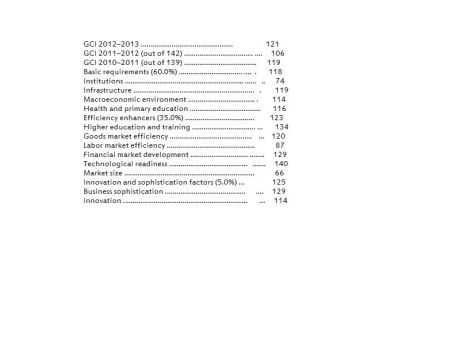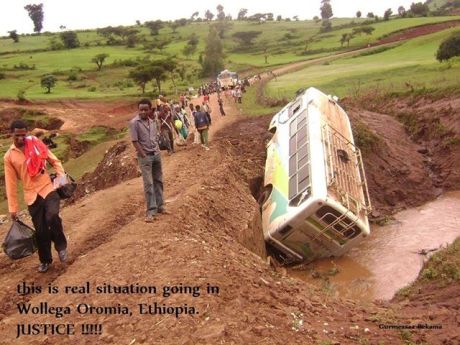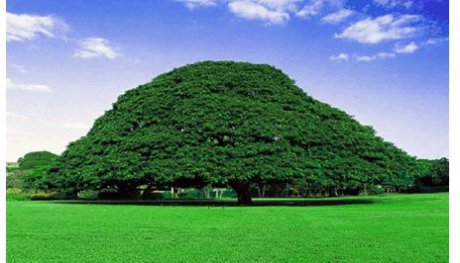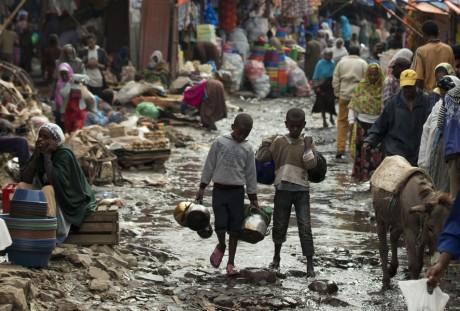The Precarious Balance of Economic productutivity and Corrupt Governance: Ethiopia Is Amongst World’s Least Competitive Countries October 29, 2013
Posted by OromianEconomist in Colonizing Structure, Corruption, Development, Dictatorship, Economics, Economics: Development Theory and Policy applications.Tags: Africa, Corruption, Ethiopia, GCI, Global Competitiveness Report, Gross domestic product, Nigeria, Oromia, Oromo, Sub-Saharan Africa, World Economic Forum
3 comments
The Corrupt Empire is uncompetitive: Ethiopia Is Amongst World’s Least Competitive Countries
Despite its damn statistics of massive long term paper growth of TPLF Ethiopia’s economy, the country is still ranked among the worst performing in the Global Competitive Index (GCI) 2013 -2014, recently released by the World Economic Forum. (see page 163 for the detail summary of the report). According to the report, Ethiopia dropped 15 places from last year’s 106th position to 121st among the 144 countries profiled.
The Global Competitive Index , which was introduced in 2004, measures how the combinations of institutions, policies, and other factors determine the level of productivity of a country. The GCI scores is calculated by putting together the 12 pillars of competitiveness, such as: institutions, infrastructure, macroeconomic environment, health and primary education, higher education and training, goods market efficiency, labour market efficiency, financial market development, technological readiness, market size, business sophistication and innovation.
According to the ranking, Ethiopia is placed in the poorest pool of economic development possible (see, the following graphics). Ethiopia ranked as a “factor driven” economy which includes Nigeria, Liberia, Lao, Mali and Yemen.There are four stages of development with innovation-driven economies being the best pool of economies.
Ethiopian economic productivity is one of the poorest despite clear advantages of its internal market and economies of scale with population over 85 million compared to other African countries. Due to its population, it has a large internal market size (66 position), only next to Nigeria (the largest internal market size in Africa, also performing poor).
GCI has identified weak basic institutional requirements (118) of Ethiopia that account 60% of the index ranking: corruption, poor infrastructure, poor primary education, poor macroeconomic environment, efficiency enhancers and technological readiness.

The GCI has noticed with Ethiopia’s economy the following among the most problematic factors for doing business:
Access to finance, corruption, inefficient government bureaucracy, inflation, policy instability, tax regulations and inadequate supply of infrastructure.
Technological readiness is also the worst performance:
Availability of latest technologies (132)
Firm-level technology absorption (139)
FDI and technology transfer (128)
Individuals using Internet, % (142)
Broadband Internet subscriptions/100 pop (131)
Mobile broadband subscriptions/100 pop (120)
Ethiopia with a population of over 85 million only produces $31.7 billion GDP with per capita income of $1 per day.
Key indicators, 2011
Population (millions) ……………………………………….85.1
GDP (US$ billions)* ……………………………….. ………31.7
GDP per capita (US$) ……………………………….. …365.2
GDP (PPP) as share (%) of world total …………..0.12
Sectoral value-added (% GDP), 2011
Agriculture …………………………………………………. ..41.9
Industry ……………………………………………………… .12.6
Services ……………………………………………………. ..45.5
Human Development Index, 2011
Score, (0–1) best ………………………………………. ….0.36
Rank (out of 187 economies) ……………………………174
Sources: IMF; UNFPA; UNDP; World Bank and GCI
The report noted that Mauritius has replaced South Africa (53rd) as the most competitive country in Sub-Saharan Africa. Ranked 45th position the country moved up nine places this year.The country’s best performance has supported by “transparent public institutions (ranked at 39th) with clear property rights and strong judicial independence and an efficient government (29th).”
Switzerland, ranked at number one is the most competitive country in the world. For top ten Sab Saharan African countries See:
http://www3.weforum.org/docs/GCR2013-14/GCR_Infographic_SubSaharanAfrica_2013-2014.jpg
Click to access WEF_Africa_Competitiveness_Report_2013.pdf
Click to access WEF_Africa_Competitiveness_Report_2013.pdf
www3.weforum.org
Prosperity Index 2013
Ethiopian: 126/142.
75.6% say gov’t is corrupt.
Satisfaction with gov’t efforts to address poverty: 21.2%.
The Governance sub-index dropped two places, to 118th, because of decreases in political rights, political constraints, the rule of law, and regulatory quality.
http://www.prosperity.com/#!/country/ETH
Copyright © Oromianeconomist 2013 and Oromia Quarterly 1997-2013. All rights reserved. Disclaimer.
Related articles
- Global Competitiveness Report 2013-2014 (pacific.scoop.co.nz)
- A prisoner of conscience’s call for sanctions against Ethiopia | Eskinder Nega (theguardian.com)
- Tyrannic Ethiopia bans access to student’s critical article (oromianeconomist.wordpress.com)
The New Scramble for Africa: Poverty, Guns And The Weapons Market September 15, 2013
Posted by OromianEconomist in Africa, Colonizing Structure, Corruption, Development, Dictatorship, Economics, Knowledge and the Colonizing Structure., Uncategorized.Tags: Africa, Genocide, Gross domestic product, Human development Index, Human rights violations, Oromia, Oromo, Sub-Saharan Africa, Weapon
1 comment so far

The world OutLine states Africa is going to spend over $20bn on defence projects over the coming decade. ‘As the European defence market becomes ever more bereft of big spenders and Asian markets face strong competition from China, Africa’s 54 states will make the last major geopolitical frontier for defence companies.’ It has been reported that whilst for various reasons there is undoubtedly significant demand for the latest weaponry in the region, large-scale arms contracts do raise questions over the future of a continent already stricken with poverty and permanent violence. It is well known Africa is run by dictators and human rights abusers. Defence contractors with out doubt are always looking to maximize profits and increase their trade, however, it is not clear whether ethical considerations will be in place in providing such weapons in the continent run by unaccountable politicians and unelected tyrants engaging in militarism, e.g Ethiopia, Rwanda and Sudan. It is worrying that scarce public money will continue to be diverted from social and economic investment and wasted into arms deals. ‘The UN has warned that 22 of the 24 lowest Human Development Index nations are in Sub-Saharan Africa, and in some instances GDP per capita is less than $200 a year. However, pumping aid into the region is not necessarily the answer. A 2005 report suggested that a staggering proportion of the $500bn of aid sent to Africa over the last forty years has been embezzled through corrupt institutions; the so-called ‘leaky begging bowl’. It would be interesting to know how much of this will fund armaments over the next decade.’ http://theworldoutline.com/2013/09/africa/
Related articles
- Guns amid poverty: the defence industry’s new ‘Scramble for Africa’ (stratrisks.com)
- Guns amid poverty: the defence industry’s new ‘Scramble for Africa’ (phantomreport.com)
- The Not-So-Great Professor: Jeffrey Sachs’ Incredible Failure to Eradicate Poverty in Africa (psmag.com)
- How happy is sub-Saharan Africa? (one.org)





You must be logged in to post a comment.